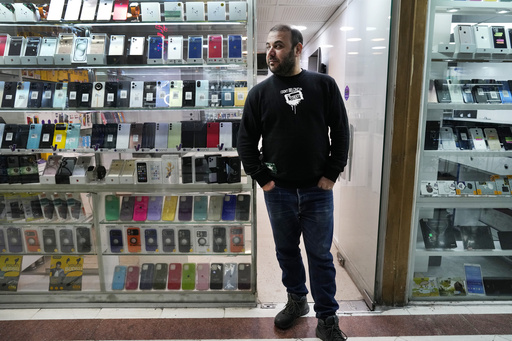TEHRAN, Iran — For architecture student Amirhossein Azizi, turning 19 was marked by a wish for the latest iPhone. However, in Iran, where economic challenges persist, his desire opened a window into the complexities of local consumerism and governmental tactics. Azizi’s acquisition of the iPhone 16 Pro Max in the capital city cost him a staggering 1.6 billion rials (approximately $1,880), along with an additional 450 million rials (around $530) for import taxes and mobile network registration.
“I’m very happy to own one of the most expensive phones in the country,” Azizi expressed. His father, Mohammad, humorously remarked nearby, “Maybe if they had to earn the money themselves, they wouldn’t be so quick to spend it.” This high-cost purchase became feasible only after the Iranian government relaxed import restrictions on luxury items, including foreign cars and new iPhones, amidst increasing public demand for such products. This policy adjustment also served to distract from the critical state of the national economy.
Despite being labeled a move to enhance Iran’s so-called “resistance economy,” the shift has coerced residents into opting for less desirable domestic vehicles, often referred to disparagingly as “death wagons.” It has also led to inflated prices for older, second-hand iPhones. Meanwhile, this strategy generates coveted tax income for the government as it grapples with ongoing international sanctions related to its nuclear initiatives. The depreciation of the rial currency is exacerbated by uncertainties surrounding U.S. foreign policy under President Donald Trump, with the rial plummeting to unprecedented lows against the dollar.
Research indicates that influential factions within Iran have capitalized on these sanctions, allowing a privileged few to thrive, according to remarks from Iranian economist Saeed Leilaz. The distinction between appearance and actual economic health is clear; the welfare of everyday citizens often fails to reflect the narratives presented by the leadership.
In fact, the concept of a “resistance economy” was initially introduced by Supreme Leader Ayatollah Ali Khamenei nearly 15 years ago after the first wave of significant sanctions related to Iran’s nuclear program emerged. Khamenei claimed, “Sanctions are not new for us. All achievements have been made, and all the great movements of the people of Iran have been launched while we were under sanctions.” The narrative has gained traction particularly since Trump reinstated sanctions following the U.S. exit from the 2015 nuclear agreement, with Iran fostering relationships with countries like China to continue selling its oil, often at discounted rates.
As a result, a new elite, closely aligned with Khamenei, is surfacing, particularly from within the ranks of the Revolutionary Guard, which has gained substantial influence under his rule. However, the disparity between the economic realities of average citizens and those of the elite is stark. The value of the rial has plummeted from trading at 32,000 to the dollar at the time of the nuclear deal to approximately 885,000 rials per dollar today, leaving many Iranians desperate for reliable stores of value like gold and real estate.
Previously, Iran imposed restrictions on importing foreign cars and new iPhones, driving consumers to scramble for older models—significantly driving up their prices, alongside foreign-used cars. Recent customs data indicates that Iran imported roughly $3.2 billion worth of mobile devices in the last Persian year, showing that high-end iPhones could play a pivotal role in remedying significant funding gaps within government budgets, despite remaining low on foreign currency reserves.
Leilaz stated that permitting imports of select goods, such as iPhones, allows the government to swiftly create a façade of progress with little financial expenditure. This strategy may be intended to bolster support for reformist President Masoud Pezeshkian amongst the upper echelons of Iranian society, though it fails to address deeper economic issues.
Former President Hassan Rouhani had implemented bans on completely built foreign cars back in 2018, purportedly to safeguard Iranian foreign reserves while simultaneously backing local car manufacturers whose vehicles are often criticized for inadequate quality and safety standards. However, analysts believe that easing restrictions on foreign imports could diminish the competitive edge of domestic manufacturers.
As the situation evolves, the Iranian government remains apprehensive about possible public unrest as socio-economic conditions deteriorate. The potential for renewed talks with Western nations, including the United States, has been gaining traction, especially as Trump pushes for drastic measures to stymie Iranian oil exports to China.
In summary, while the Tehran car show and recent economic policy adjustments may offer a glimmer of hope, the overarching reliance on the U.S. dollar continues to dictate the nation’s economic landscape, leaving many uncertain about the future of expenses in a country where inflation remains rampant. “Everything depends on the dollar,” noted Saeed Maleki, highlighting the continued volatility and uncertainty that characterizes life in contemporary Iran.



